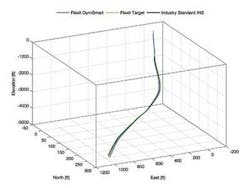Downhole survey equipment adapted for HP/HT needs
Downhole survey tools for the oil and gas industry are now available from Flexit. The company, part of the Australia-based Imdex group and well-known in the mining and geo-thermal drilling sectors, is expanding its operations to include the oil and gas industry.
Flexit, based at Vallentuna outside Stockholm, was acquired by Imdex last year. It now acts as the new owner’s R&D facility within the drilling and downhole instrumentation division, according to general manager Dag Billger.
Earlier this year, Imdex also acquired the German company System Entwicklungs GmbH (SEG), whose main product is a North-seeking tool named Target INS (Inertial Navigation System). Target INS will now be marketed by Flexit under the name Flexit Target INS, and completes Flexit’s range of downhole survey tools. There are two other main tools, both developed by Flexit itself: the High-Temperature MultiSmart (HTMS), which is integrated into its own heat-shielded running gear for surveying in non magnetic environments, and Gyro-Smart, for surveying in magnetic environments and inside drill rods.
GyroSmart will be available to oil and gas customers by early fall and the HTMS will follow soon after, Billger says. While Target INS was originally developed by SEG partly with the oil and gas market in mind, Flexit has further developed its own tools to meet the needs of operations in much deeper wells with high temperatures and pressures. “We’ve put them in pressure housing, fitted them with heat shielding and made them proof against corrosion,” says Billger.
Flexit’s entry into the oil and gas sector is being aided by two long-standing partners, US surveying company Multi-Shot and Australian company DHS Oil. During the past year a series of field tests has been carried out in close cooperation with Multi-Shot to demonstrate GyroSmart’s performance in an oil and gas environment. The results (see figure) indicate that the tool is capable of accurately surveying deep vertical holes which are typical for the oil and gas industry.
“Our accuracy is as good as the competition’s, and certainly better than many existing tools,” says Billger. “We believe our tools are also more rugged and easier to use.” The tools come with “user-friendly” software. Data is made available to the customer immediately after the survey at the field. Repairs are implemented out with a short turnaround.
The top-of-the-range tool in the company’s portfolio is the Flexit Target INS, a true north-finding inertial navigation system designed for continuous 3D surveying of small and large diameter boreholes of any inclination. It communicates its position to the surface in real time through a conducting wireline.
The Target tool has an accuracy of typically one foot after 1,000 ft (305 m) traveled. For deep borehole applications it can withstand pressures of 15,000 psi and temperatures of 175º C (347° F) for up to 10 hours using an optional heat shield.
For less demanding survey applications cost-effective solutions are available in the shape of the GyroSmart and MultiSmart tools. GyroSmart is the first and so far only micro-system based surveying tool. It was developed by Claes Ericsson, a well-known name in the field of downhole surveying. Ericsson also founded Flexit and was the owner prior to its acquisition by Imdex.
GyroSmart uses MEMS micro electro-mechanical system technology. The digital micro-gyroscopes are so small they fit easily onto a finger-tip, says Billger. The tool is lightweight and sturdy, with no moving parts, rendering it insensitive to shock. In contrast, the performance of tools based on conventional gyro technology, with mechanically spinning masses, is often adversely affected by mechanical disturbance.
GyroSmart, which can be deployed by slickline, uses three micro gyros and three accelerometers to record its motion and through inertial navigation track its relative change in attitude from a given starting direction. It is non-magnetic and ideal for surveying inside casing and drill rods. Power is provided on-board by a rechargeable battery pack, thus avoiding the need for expensive conductor wireline or cable heads. Data is stored on-board in a memory module and can be downloaded to a field PC via Bluetooth back at the surface.
The HTMS tool is designed for multi-shot surveying in a non-magnetic environment. The tool is operated using the SmartPad software which takes and records readings. SmartPad runs on any Windows mobile platform and is suitable for handheld units such as the TDS Nomad, says Billger. Back at the surface the data is transmitted from the tool using an infrared communication link to the handheld data pad from where it can also be downloaded to a PC application.
For more information contact Dag Billger, Flexit. Tel +46 8 514 303 62, fax +46 8 514 303 63,[email protected], www.flexit.se

